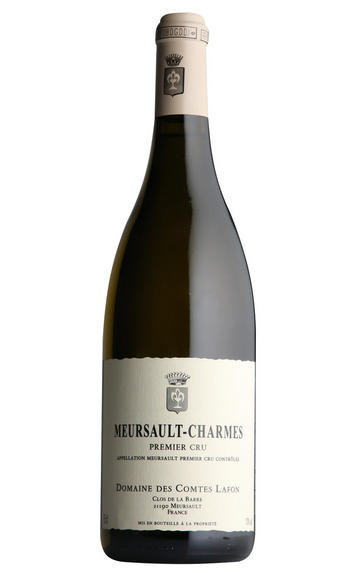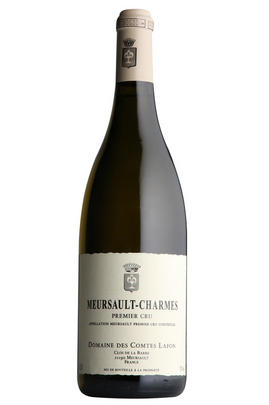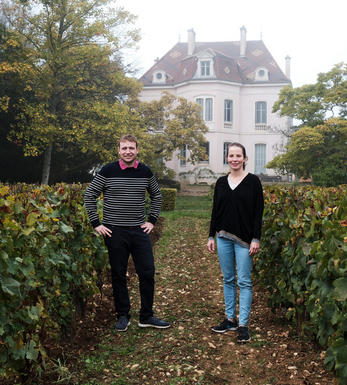
2020 Meursault, Les Charmes, 1er Cru, Domaine des Comtes Lafon, Burgundy

Critics reviews
The most perfect balance by the book, between sugar and acidity, a vineyard that came through the drought very easily. Very pure, very concentrated, yet with not a single point of additional ripeness. There is a natural tension throughout, a complete sense of harmony and the full volume of fruit continues at an even pace right across the palate. Fresh plums, and exceptional persistence.
Jasper Morris MW, Inside Burgundy (October 2021)
A blend of fruit coming from 35+ and 75+-year-old vines in Charmes Dessus, which is generally considered to be the best part; the parcel is situated directly below Perrières and abutting Combettes.
Like the Porusots, the nose is largely masked by leesy reduction. Much more interesting are the delicious and highly energetic flavours that display fine delineation on the sneaky long, overtly stony and equally austere finale. Lovely juice.
Drink from 2030 onward
Allen Meadows, Burghound.com (June 2022)
The 2020 Meursault Les Charmes 1er Cru has a very pure with honeysuckle, orange zest and walnut, gaining intensity with time. This is a multi-dimensional nose, kaleidoscopic. The palate is well balanced with an almost Corton-Charlemagne-like entry, a little more austere compared to the previous vintage with a lightly spiced finish. Very fine, quite intellectual, this is a scintillating, almost audacious Meursault-Charmes that has the edge over the Perrières (a view concurred by the man who made it!).
Drink 2025 - 2042
Neal Martin, Vinous.com (December 2021)
The 2020 Meursault 1er Cru Charmes is brilliant, offering up a complex bouquet of pear, crisp stone fruits, clear honey, baking spices, wheat toast and hazelnuts. Medium to full-bodied, deep and taut, it's extremely concentrated, with racy acids and an abundance of chalky structuring extract. This site has really excelled this year.
Dominique Lafon celebrated his official retirement in December 2021, after 37 years at the domaine, and is handing over the reins to daughter Léa and nephew Pierre, even if he will surely still be on hand to help the new generation for many years to come. He can reflect with satisfaction on an important career, as the first generation of the Lafon family to become a farmer and grow the grapes he vinified and as one of his generation's leading pioneers of organic farming. And he can certainly be satisfied with the 2020 vintage, a terrific success at this address. As the accompanying notes attest, I was very impressed, and special mention is owing to the best set of red wines I can remember tasting here.
Drink 2022 - 2035
William Kelley, Wine Advocate (January 2022)
Cask sample. Mid lemon. Citrus defining a rounded, full fruit. Quite austere today, but with a great future ahead. Cut-crystal acidity.
Drink 2025 - 2035
Matthew Hayes, JancisRobinson.com (January 2022)
Rich and powerful, with aromas of ripe apple, butter and toast. The wine is certainly dense, yet there is no lack of balancing acidity and the wine remains vibrant and fresh, even in a hot year like 2020. This is from a magnificent holding of 1.71ha on the southern (Puligny) end, next to the Combettes of Sauzet. The grapes are lightly crushed and gently pressed prior to fermentation in cask (one-quarter new).
Drink 2025 - 2040
Charles Curtis MW, Decanter.com (November 2021)
About this WINE

Domaine des Comtes Lafon
Domaine des Comtes Lafon is based in Meursault, where it has holdings in each of the finest Cru and Premier Cru vineyards in Meursault. They have a reputation for maintaining the signature character of each site in their wines. They don’t rest on their laurels, though, their red wines from their Volnay Premiers Crus are increasingly popular and should not be overlooked.
The domaine was established in 1869 by the Boch family and has remained in their care ever since – only changing its name when Marie Boch married Comte Jules Lafon in ‘94. When fourth-generation Dominique Lafon took charge in 1985, Domaine des Comtes Lafon already had a reputation for unconventional yet outstanding white wines.
At the time, most of the vineyards were leased out to sharecroppers; but by ‘93 Dominique had reclaimed all of his family’s vineyards and assumed full control of the domaine. Not only are the Lafons’ 15 individual vineyards located in the best appellations in Meursault and Volnay, but they tend to be very well situated within them, and are now cultivated according to organic and biodynamic principles. In 2010, Jasper Morris wrote in his book ‘Inside Burgundy’, that their white wines were “now consistently among the best in Burgundy, while since 1989 the reds have reached the top division”.
In ‘99 the Lafon family branched out, buying a domaine in the Mâconnais at Milly-Lamartine and making wines under the name of ‘Les Héritiers du Comte Lafon’. More recently, Dominique Lafon has also established a small label of his own bearing his own name.
When Dominique Lafon’s father René took over the domaine in 1956, he undertook a significant replanting programme in cooperation with the sharecroppers who managed much of his vineyards. Care for the vines is still paramount under Dominique’s stewardship; all vineyards returned to family control in ‘93, were fully converted to organic viticulture in ‘95 and to biodynamic in ‘98. The average age of the vines is maintained at around 40 years, and yields are kept low at about 35 hectolitres per hectare.
Wines are made differently each year due to practical reasons and vintage variation. However, there are some common practices.
Chardonnay grapes are whole-bunch pressed, settled in tanks at cool temperatures and then fermented and aged in wood. No new oak is used for the village wines; 25-40% new oak is typically used for the Premiers Crus and 100% for Le Montrachet, though these are subsequently racked into older wood where they spend a second winter before bottling.
The Pinot Noir grapes are 100% destemmed and vinified in stainless steel. Wines are matured for 18-22 months in about 30% new oak and are racked twice before bottling without fining or filtration whenever possible.
Domaine des Comtes Lafon have been certified as organic since 1995, and although biodynamic principles have been used since ‘98, they have not sought to become Demeter certified – citing “too much paperwork” as the main reason. The two newer businesses in the family portfolio are also organic, and when new vineyards are acquired, each is converted as soon as possible thereafter.

Meursault
There are more top producers in Meursault than in any other commune of the Côte d’Or. Certainly it is the most famous and popular of the great white appellations. Its wines are typically rich and savoury with nutty, honeyed hints and buttery, vanilla spice from the oak.
Even though it is considerably larger than its southerly neighbours Chassagne and Puligny, Meursault contains no Grands Crus. Its three best Premiers Crus, however – Les Perrières, Les Genevrières and Les Charmes – produce some of the region’s greatest whites: they are full, round and powerful, and age very well. Les Perrières in particular can produce wines of Grand Cru quality, a fact that is often reflected in its price. Meursault has also been one of the driving forces of biodynamic viticulture in the region, as pioneered by Lafon and Leflaive.Many of the vineyards below Premier Cru, known as ‘village’ wines, are also well worth looking at. The growers vinify their different vineyard holdings separately, which rarely happens in Puligny or Chassagne. Such wines can be labelled with the ‘lieu-dit’ vineyard alongside (although in smaller type to) the Meursault name.
Premier Cru Meursault should be enjoyed from five to 15 years of age, although top examples can last even longer. Village wines, meanwhile, are normally at their best from three to 10 years.
Very occasionally, red Meursault is produced with some fine, firm results. The best red Pinot Noir terroir, Les Santenots, is afforded the courtesy title of Volnay Santenots, even though it is actually in Meursault.
- 305 hectares of village Meursault. The best vineyards include Clos de la Barre, Tesson, Chevalières, Rougeot, Narvaux
- 132 hectares of Premier Cru vineyards (17 in all). The finest vineyards include Les Perrières, Les Genevrières and Les Charmes
- Recommended producers: Comte Lafon, Arnaud Ente, Coche Dury, Guy Roulot, Jean-Philippe Fichet, Patrick Javillier, François Jobard, Michel Bouzereau
- Recommended restaurant: Le Chevreuil

Chardonnay
Chardonnay is often seen as the king of white wine grapes and one of the most widely planted in the world It is suited to a wide variety of soils, though it excels in soils with a high limestone content as found in Champagne, Chablis, and the Côte D`Or.
Burgundy is Chardonnay's spiritual home and the best White Burgundies are dry, rich, honeyed wines with marvellous poise, elegance and balance. They are unquestionably the finest dry white wines in the world. Chardonnay plays a crucial role in the Champagne blend, providing structure and finesse, and is the sole grape in Blanc de Blancs.
It is quantitatively important in California and Australia, is widely planted in Chile and South Africa, and is the second most widely planted grape in New Zealand. In warm climates Chardonnay has a tendency to develop very high sugar levels during the final stages of ripening and this can occur at the expense of acidity. Late picking is a common problem and can result in blowsy and flabby wines that lack structure and definition.
Recently in the New World, we have seen a move towards more elegant, better- balanced and less oak-driven Chardonnays, and this is to be welcomed.


Buying options
Add to wishlist
Description
A blend of fruit coming from 35+ and 75+-year-old vines in Charmes Dessus, which is generally considered to be the best part; the parcel is situated directly below Perrières and abutting Combettes.
Like the Porusots, the nose is largely masked by leesy reduction. Much more interesting are the delicious and highly energetic flavours that display fine delineation on the sneaky long, overtly stony and equally austere finale. Lovely juice.
Drink from 2030 onward
Allen Meadows, Burghound.com (June 2022)
wine at a glance
Delivery and quality guarantee